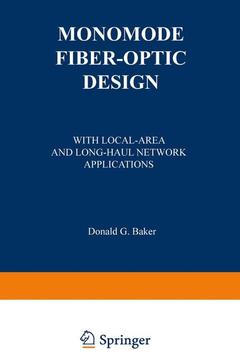Monomode Fiber-Optic Design, Softcover reprint of the original 1st ed. 1987 With Local-Area and Long-Haul Network Applications
Langue : Anglais
Auteur : Baker Donald G.

Fiber optics is a transmission technique that uses electrical signals to modulate a light source and thereby produce an optical signal proportional to the electrical signal. These optical signals contain information that is transmitted via a glass waveguide to a light-sensitive receiver. Fiber optics has a distinct advantage over copper networks for some applications. The objective of this book is to explore monomode, as opposed to multimode, applications of fiber optics to local area networks (LANs), which have become a rather important aspect of this technology because of the ever-increasing growth of LANs. Monomode fiber optics requires the use of coherent light sources such as laser diodes, YAGs, and HeNe lasers, to name just a few. It has some distinct advantages over multimode that this text will investigate in a cursory manner. (The author's previous book on multimode fiber optics, Fiber Optic Design and Applications, published by Reston, would be helpful but not necessary to aug ment this text.) Monomode (or single-mode) fiber optics is the present direction of the state of-the-art because of its superior performance. Since a few problems existed that limited the growth of monomode technology at the time this book was being written, several sections of the text will be devoted to examining the shortcom ings as well as the performance advantages of this technology.
1. Introduction.- 2. Waveguide Analysis.- Single-Mode Waveguide Analysis.- Loss Mechanisms.- Material Attenuation.- Waveguide Attenuation.- Dispersion in Single-Mode Waveguide.- Standard Waveguide Profiles.- Bandwidth Considerations.- Test Equipment.- Laser.- Detectors.- Beamsplitters and Couplers.- Boxcar Average.- Launcher.- Apertures.- Applications of the OTDR.- Review Problems.- References.- 3. Transmitters.- Solid-State Laser Physics.- Long-Wavelength Sources.- Edge-Emitting Diodes.- Gas Lasers.- YAG Lasers.- Laser Feedback Techniques.- Temperature Control.- Optical FeedbackCircuitry.- Digital Transmitter Design with Lasers.- LinearTransmitters.- Linearizing LED Transmitters.- References.- 4. Receivers.- PiN Diode Detectors.- Avalanche Photodiode Detectors (APD).- Linear Receivers.- Microwave Preamplifier Biasing.- Receiver Design.- Preamplifier Noise.- Review Problems.- References.- 5. Waveguide Terminations and Splices.- Misalignment Losses.- Connectors.- Splices.- Common Commercial Connector Designs.- Commercially Available Splices.- Review Problems.- References.- 6. Integrated Optic and Network Components.- Fiber-Optic Switches and Couplers (Active).- Couplers (Fixed).- Wavelength Multiplexing/Demultiplexing.- Review Problems.- References.- 7. Integrated Optics.- Integrated Optics Components.- Mode Numbers and Cut-off Derivations.- Coupling to Integrated Optics.- Fiber-Optic Modulators.- VLSI Techniques Applied to Integrated Optics.- Review Problems.- References.- 8. Local Area Networks.- International Standards Organization (ISO) Network Model.- Common Networks.- Physical Layer.- Simplex Links.- Review Problems.- References.- 9. Local Area Networks Applied to Single-Mode Fiber-Optic Technology.- Network Topology.- Graph Theory.- Network Flow.- Time Delay Analysis.- Channel Capacity.- Noise Considerations.- Backbone Design.- Network Layer (Virtual Circuits).- Datagram.- Routing Techniques.- Local Area Networks.- Token Passing Networks.- Hybrid Star Network.- Gateways.- Broadband Fiber-Optic Networks.- Review Problems.- References.- 10. Long-Haul Networks.- M-ary Codes.- Long-Distance Transmission Systems (Over 10 Kilometers).- Long-Distance Cable Plant and the Loss Budget.- High-Sensitivity Receivers.- Review Problems.- References.- 11. Fiber-Optic Sensors.- Sagnac Effect.- Temperature Sensitivity.- Review Problems.- References.- 12. Angular Division Multiplexer (ADM).- Modal Analysis.- Crosstalk.- ADM Bandwidth Considerations.- Loss Mechanisms.- Noise.- ADM Transmitters.- ADM Receivers.- Cable Plant Design.- ADM Demultiplexer.- Review Problems.- References.
Date de parution : 03-2012
Ouvrage de 490 p.
15.2x22.9 cm
Disponible chez l'éditeur (délai d'approvisionnement : 15 jours).
Prix indicatif 52,74 €
Ajouter au panierMots-clés :
© 2024 LAVOISIER S.A.S.



